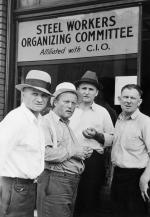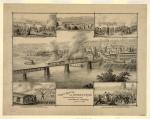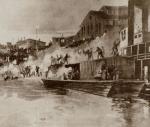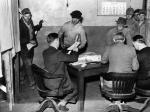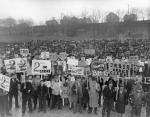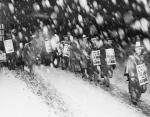Chapter 3: Building a Union
"The most militant local union leaders, who rise to the surface in the organizing stage of unions, fall by the side when the union moves into the stage of constructive relations with management." Take Stanley Orlosky. Like many steel workers he had joined the union to improve the inhumane working conditions, to press for decent pay, and to prevent workers from "getting fired for talking."
But in 1940 he was thrown out of the pioneering Steel Workers Organizing Committee after he accused the union of selling the men down the river. "The men that tried me in the local, I had a hard time getting to join the union a few years ago. Now they're big union shots."
Steel Workers Organizing Committee after he accused the union of selling the men down the river. "The men that tried me in the local, I had a hard time getting to join the union a few years ago. Now they're big union shots."
Though sad, the Orlosky story, related in The Dynamics of Industrial Democracy (1942), quoted above, is extraordinary in one way: none of it could have occurred just a decade earlier. In 1930 Pennsylvania steelworkers had negligible power to negotiate contracts in the mills, precious little freedom in the mill towns, and there was absolutely no talking back to bosses or town officials.
steelworkers had negligible power to negotiate contracts in the mills, precious little freedom in the mill towns, and there was absolutely no talking back to bosses or town officials.
Since steel companies encouraged managers to run for local offices, boss and burgess might be the same person. Too often bosses still acted much like one U.S. Steel executive had put it: "I have always had one rule: if a workman sticks up his head, hit it."
One obstacle to effective steel organizing was too many unions. This was a blessing and a curse inherited from the vibrant tradition of craft unions, prominent since colonial times. Unions formed by carpenters, bricklayers, printers, iron workers, machinists, millwrights, and other skilled workers turned young apprentices into journeymen, and journeymen into masters who could open their own shops.
For decades, the skilled trades grew up alongside American industry. Trade unionists eventually formed the American Federation of Labor in 1886, headed by cigarmaker Samuel Gompers.
American Federation of Labor in 1886, headed by cigarmaker Samuel Gompers.
Gompers wanted strong national unions for skilled, white, male workers - and left other workers on their own - but changes in American industry soon gutted Gompers' skilled-worker strategy. From the 1870s onward, steel mills employed thousands of semiskilled operatives and unskilled laborers, who had no effective union body speak for them.
In 1876 skilled iron puddlers and rolling mill workers had organized the Amalgamated Association of Iron, Steel and Tin Workers. The Amalgamated's focus on skilled iron workers, however, prevented it from being an effective force in the new steel industry. The Amalgamated fought, and lost, the Homestead strike of 1892 in its stronghold in steel, as well as strikes in 1901 and 1909.
Homestead strike of 1892 in its stronghold in steel, as well as strikes in 1901 and 1909.
Starting in the late 1800s a tidal wave of "new" immigrants from southern and eastern Europe filled most lesser-skilled steel mill jobs. Lumped together by native white Americans as "Hunkies" or "Huns," they, in fact, included Italians, Poles, Russians, Greeks, Slovaks, Bohemians, Croats, Serbs, Magyars, and others. Hard work was about the only thing they had in common. "There are different kinds of work, heavy and light," explained one immigrant, "but a man from our country cannot get the light." Too often, tensions flared as native whites resented the newcomers taking jobs for low pay.
Coal and steel towns were further divided by differences in culture, religion, and language. One of the stranger moments in the tragic Morewood Massacre of 1891 was the dentist-commander of the National Guard shouting a warning - in Hungarian - just moments before his guardsmen's bullets cut into a crowd of striking Italian, Bohemian, Hungarian, and Polish workers. Most never knew what hit them.
Morewood Massacre of 1891 was the dentist-commander of the National Guard shouting a warning - in Hungarian - just moments before his guardsmen's bullets cut into a crowd of striking Italian, Bohemian, Hungarian, and Polish workers. Most never knew what hit them.
Unease with immigrants was not limited to the coal and steel communities. Large cities filling up with "dangerous," "foreign," "alien," "radicals" alarmed many middle-class Americans. Immigrants, long supposed indifferent to unionism, actually led the violent and fiercely fought 1909 McKee's Rocks Strike. Then the
1909 McKee's Rocks Strike. Then the  Ironworkers Union's ill-considered dynamiting campaign tarred unionism with the brush of radicalism.
Ironworkers Union's ill-considered dynamiting campaign tarred unionism with the brush of radicalism.
During World War I, workers did benefit from the labor-friendly provisions of the War Labor Board. "Working people were made to believe they amounted to something," as labor leader Mother Jones explained in her
Mother Jones explained in her  autobiography. Their enthusiasm turned to bitterness, however, when companies flagrantly disregarded the War Labor Board's findings.
autobiography. Their enthusiasm turned to bitterness, however, when companies flagrantly disregarded the War Labor Board's findings.
In 1919, a loosely structured "National Committee" organized angry steel workers for a nationwide job action. Tensions ran high that summer, especially after the killing of union organizer
organized angry steel workers for a nationwide job action. Tensions ran high that summer, especially after the killing of union organizer  Fanny Sellins and the arrests of Mother Jones in Duquesne and Homestead during the Monongahela Valley "free speech" campaigns. When the strike call went out that fall more than a quarter million workers walked off the job in the great
Fanny Sellins and the arrests of Mother Jones in Duquesne and Homestead during the Monongahela Valley "free speech" campaigns. When the strike call went out that fall more than a quarter million workers walked off the job in the great  steel strike of 1919, shutting down steel plants across the country.
steel strike of 1919, shutting down steel plants across the country.
Already suspicious of foreigners, newspapers across the nation reported that foreign radicals caused the strike. "Bolshevism offers no possibility of advance for labor," warned the Harrisburg Telegraph. "It is an imported theory fomented by foreigners." Pittsburgh papers hostile to the striking immigrants ran daily headlines on how the strike was failing, as full page ads in more than eight languages urged strikers to be "100% American" and return to work.
The striking steelworkers held out for more than three months before returning to the mills in defeat. After that, the struggle to organize Pennsylvania's steel mills fell silent for more than a decade.
In the 1930s, a sea change in state and federal government allowed steel unionism to flourish. In 1933, Labor Secretary Frances Perkins came to Homestead, Pennsylvania, and when the town's officials refused her permission to address a group of steel workers, met with them at a nearby post office. Over federal property the minions of the steel companies no longer had control.
Frances Perkins came to Homestead, Pennsylvania, and when the town's officials refused her permission to address a group of steel workers, met with them at a nearby post office. Over federal property the minions of the steel companies no longer had control.
The labor friendly New Deal reforms, especially the landmark Wagner Act of 1935, put the federal government squarely on the side of labor unions. Equally important were changes in the state of Pennsylvania. In the early 1930s Governor Gifford Pinchot intervened on behalf of labor organizers, and his wife later addressed labor rallies in steel towns.
Gifford Pinchot intervened on behalf of labor organizers, and his wife later addressed labor rallies in steel towns.
During the steel organizing campaign of the late 1930s lieutenant governor Thomas Kennedy was also secretary-treasurer of the United Mine Workers. Gone were the days when union organizers were terrorized by the state's notorious Coal and Iron Police, which often operated as the private police of steel companies.
In the early 1900s, John L. Lewis, head of the United Mine Workers of America, had successfully organized coal miners everywhere except in the "captive mines" owned by the stubbornly antiunion steel companies. After breaking with the AFL, Lewis in 1936 helped form the Committee for Industrial Organization and the Steel Workers Organizing Committee (SWOC). His trusted vice-president, Phil Murray of Pennsylvania, became the chairman of SWOC.
Committee for Industrial Organization and the Steel Workers Organizing Committee (SWOC). His trusted vice-president, Phil Murray of Pennsylvania, became the chairman of SWOC.
Well disciplined and tightly organized, SWOC absorbed the Amalgamated Association - then consisting of "some old puddlers and people like that" - and soon collected 125,000 membership cards.
Myron Taylor, U.S. Steel's chairman, saw the writing on the wall. The victory of the United Autoworkers sit-down strike at Flint, Michigan in February 1937, and the need for labor peace to meet large armor plate orders from Europe pushed him to meet secretly with Lewis. That March, Taylor agreed to formally recognize SWOC.
Scarcely a month later, the Supreme Court handed down a landmark ruling in National Labor Relations Board v. Jones and Laughlin Steel Corp. that affirmed workers' rights to choose representatives and to bargain collectively with employers over wages, hours, and working conditions.
National Labor Relations Board v. Jones and Laughlin Steel Corp. that affirmed workers' rights to choose representatives and to bargain collectively with employers over wages, hours, and working conditions.
In May, workers at the vast Jones and Laughlin Aliquippa plant voted for SWOC as their representative and won a contract after a tense two-day strike. A rear-guard action by the resolutely antiunion "Little Steel" companies, led by Bethlehem's Eugene Grace and Republic Steel's Tom Girdler, delayed until 1941 the steel industry's full recognition of workers' rights to organize.
Eugene Grace and Republic Steel's Tom Girdler, delayed until 1941 the steel industry's full recognition of workers' rights to organize.
By the end of World War II, however, the steelworkers' union had fully arrived. A profile in Fortune magazine described the United Steelworkers of America as a business union "in the best sense of the word." The steelworkers' offices were in the top office buildings, and its officers were as well dressed as any corporate executive. In sharp contrast with the democratic and ill-disciplined automobile workers, the steelworkers according to Fortune "formed . . . a compact, hard-hitting phalanx ready to face employers with no sabotaging or ideological sass from the rear ranks."
Philip Murray, SWOC's founding chairman, and David J. McDonald, its first secretary-treasurer, led the steelworkers from 1936 to 1965. During these decades, with the gaining of pensions, vacations, holidays, and medical benefits, blue-collar steel workers often became middle-class consumers.
But in 1940 he was thrown out of the pioneering
Though sad, the Orlosky story, related in The Dynamics of Industrial Democracy (1942), quoted above, is extraordinary in one way: none of it could have occurred just a decade earlier. In 1930 Pennsylvania
Since steel companies encouraged managers to run for local offices, boss and burgess might be the same person. Too often bosses still acted much like one U.S. Steel executive had put it: "I have always had one rule: if a workman sticks up his head, hit it."
One obstacle to effective steel organizing was too many unions. This was a blessing and a curse inherited from the vibrant tradition of craft unions, prominent since colonial times. Unions formed by carpenters, bricklayers, printers, iron workers, machinists, millwrights, and other skilled workers turned young apprentices into journeymen, and journeymen into masters who could open their own shops.
For decades, the skilled trades grew up alongside American industry. Trade unionists eventually formed the
Gompers wanted strong national unions for skilled, white, male workers - and left other workers on their own - but changes in American industry soon gutted Gompers' skilled-worker strategy. From the 1870s onward, steel mills employed thousands of semiskilled operatives and unskilled laborers, who had no effective union body speak for them.
In 1876 skilled iron puddlers and rolling mill workers had organized the Amalgamated Association of Iron, Steel and Tin Workers. The Amalgamated's focus on skilled iron workers, however, prevented it from being an effective force in the new steel industry. The Amalgamated fought, and lost, the
Starting in the late 1800s a tidal wave of "new" immigrants from southern and eastern Europe filled most lesser-skilled steel mill jobs. Lumped together by native white Americans as "Hunkies" or "Huns," they, in fact, included Italians, Poles, Russians, Greeks, Slovaks, Bohemians, Croats, Serbs, Magyars, and others. Hard work was about the only thing they had in common. "There are different kinds of work, heavy and light," explained one immigrant, "but a man from our country cannot get the light." Too often, tensions flared as native whites resented the newcomers taking jobs for low pay.
Coal and steel towns were further divided by differences in culture, religion, and language. One of the stranger moments in the tragic
Unease with immigrants was not limited to the coal and steel communities. Large cities filling up with "dangerous," "foreign," "alien," "radicals" alarmed many middle-class Americans. Immigrants, long supposed indifferent to unionism, actually led the violent and fiercely fought
During World War I, workers did benefit from the labor-friendly provisions of the War Labor Board. "Working people were made to believe they amounted to something," as labor leader
In 1919, a loosely structured "National Committee"
Already suspicious of foreigners, newspapers across the nation reported that foreign radicals caused the strike. "Bolshevism offers no possibility of advance for labor," warned the Harrisburg Telegraph. "It is an imported theory fomented by foreigners." Pittsburgh papers hostile to the striking immigrants ran daily headlines on how the strike was failing, as full page ads in more than eight languages urged strikers to be "100% American" and return to work.
The striking steelworkers held out for more than three months before returning to the mills in defeat. After that, the struggle to organize Pennsylvania's steel mills fell silent for more than a decade.
In the 1930s, a sea change in state and federal government allowed steel unionism to flourish. In 1933, Labor Secretary
The labor friendly New Deal reforms, especially the landmark Wagner Act of 1935, put the federal government squarely on the side of labor unions. Equally important were changes in the state of Pennsylvania. In the early 1930s Governor
During the steel organizing campaign of the late 1930s lieutenant governor Thomas Kennedy was also secretary-treasurer of the United Mine Workers. Gone were the days when union organizers were terrorized by the state's notorious Coal and Iron Police, which often operated as the private police of steel companies.
In the early 1900s, John L. Lewis, head of the United Mine Workers of America, had successfully organized coal miners everywhere except in the "captive mines" owned by the stubbornly antiunion steel companies. After breaking with the AFL, Lewis in 1936 helped form the
Well disciplined and tightly organized, SWOC absorbed the Amalgamated Association - then consisting of "some old puddlers and people like that" - and soon collected 125,000 membership cards.
Myron Taylor, U.S. Steel's chairman, saw the writing on the wall. The victory of the United Autoworkers sit-down strike at Flint, Michigan in February 1937, and the need for labor peace to meet large armor plate orders from Europe pushed him to meet secretly with Lewis. That March, Taylor agreed to formally recognize SWOC.
Scarcely a month later, the Supreme Court handed down a landmark ruling in
In May, workers at the vast Jones and Laughlin Aliquippa plant voted for SWOC as their representative and won a contract after a tense two-day strike. A rear-guard action by the resolutely antiunion "Little Steel" companies, led by Bethlehem's
By the end of World War II, however, the steelworkers' union had fully arrived. A profile in Fortune magazine described the United Steelworkers of America as a business union "in the best sense of the word." The steelworkers' offices were in the top office buildings, and its officers were as well dressed as any corporate executive. In sharp contrast with the democratic and ill-disciplined automobile workers, the steelworkers according to Fortune "formed . . . a compact, hard-hitting phalanx ready to face employers with no sabotaging or ideological sass from the rear ranks."
Philip Murray, SWOC's founding chairman, and David J. McDonald, its first secretary-treasurer, led the steelworkers from 1936 to 1965. During these decades, with the gaining of pensions, vacations, holidays, and medical benefits, blue-collar steel workers often became middle-class consumers.









